“When I’m photographing I see life. That’s what I deal with,” Garry Winogrand once said. Life, for him, was the energy of the street in all its unruly momentum. In the 1960s and 70s, he defined street photography as an attitude as well as a style – and it has laboured in his shadow ever since, so definitive are his photographs of New York.
Thirty years after his untimely death in 1984, aged 56, Winogrand’s legend endures: the instinctive genius of American photography whose disinterest in technique was matched by an obsessive devotion to shooting on the street all day, every day. Towards the end of his life, photographing became a kind of mania – he left behind 6,500 rolls of unprocessed film.
As this retrospective at Jeu de Paume in Paris shows, the challenge of containing the photographer’s frantic vision is a singular one, not least because, as curator Leo Rubinfien points out, he “often worked in a headlong way, preferring to spend another day shooting rather than processing his film or editing his pictures”. Perhaps because of his seeming disregard for his own archive, Winogrand has been, as Rubinfien puts it, “the most sparsely studied and least understood of his peers, who included Diane Arbus, Robert Frank and Lee Friedlander.”
Not only that, but Winogrand’s energy is so overpowering and his vision so democratic and wide-ranging that the curious visitor may find it hard to find a way into his work. This chronological show, which arrives from the Met in New York, is an instructive place to start insofar as it retraces and illuminates Winogrand’s headlong creative journey without taming his restless spirit.
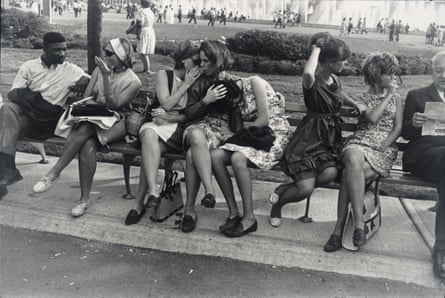
It begins – where else? – on the streets of 1950s New York or, to be precise, the crowded sidewalks between midtown and Central Park, which give off the aura of a city still stuck in an earlier, tougher time. This section, titled Down From the Bronx, includes two very early, atypically spartan images of lone pedestrians wandering deserted snowy streets. Soon, though, we see the beginnings of a style – a stern woman shot up-close on a bustling street, a cigarette clutched between her lips. She may be unaware of Winogrand’s presence, but the two other passersby are not. They cast coldly suspicious eyes at his intrusive lens.
This single image signals much of what is to come. The intimacy, the awkward expression of the central subject and the accusatory stares of passersby are the results of a naturally bullish approach – a working-class Bronx attitude – and they recur throughout his life’s work. While his contemporary, Joel Meyerowitz, stalked the streets of New York trying to be invisible, Winogrand did not mind being noticed. Revealingly, though, many of his reluctant subjects only seem to register his presence at the very moment he presses the shutter. In one of his best-known images, a chubby girl stares at him curiously, while another, older girl catches him out of the corner of her eye as she is being snogged by her boyfriend. As is often the case with Winogrand’s photographs, you long to find out what happened next.
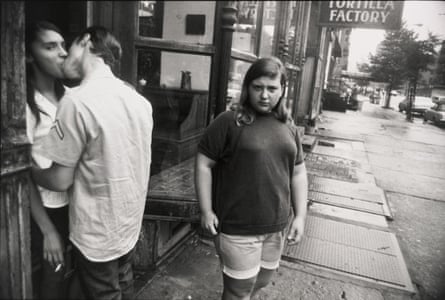
There’s a similar moment when a dapper Italian-looking gent strides towards Winogrand’s camera, hand upturned and an expression that says “What gives?” And in one famous shot from 1959, a monkey glares at his camera from the rear of an open-top car, while the couple in the front seats seem more concerned with the creature’s angry reaction than with the intruder who provoked it. You cannot help but feel the monkey was on to something – a stranger coming this close does not usually have one’s best intentions at heart. Winogrand, though, was not a cruel photographer in the way Arbus was or, more pertinently, Bruce Gilden can be. Arbus, in fact, nailed it when she described Winogrand as “an instinctive, nearly primitive ironist, so totally without malice, so unflinching, even cheerful ...”.
His subjects tend to stare back at his camera sadly or in a slightly bewildered fashion. Around them, the world tilts – the horizon line is seldom level – but there is always what might be called a Winograndian logic to his compositions, an instinctive grasp of the geometry of a good photograph. His interest was the rhythm of the streets and the people who created it. There is a melancholy visual poetry in all these anonymous passing souls with their sad, strained, beleaguered or beautiful faces as they go about their daily business. Again and again, Winogrand captured photographs within photographs, smaller narratives within the bigger picture. A row of animated people on a park bench could easily be broken down into three distinct images about intimacy, fatigue and human curiosity. As it is, though, it is pure Winogrand: a metaphor for city life with all its snatched moments of quiet relief amid the constant distraction.
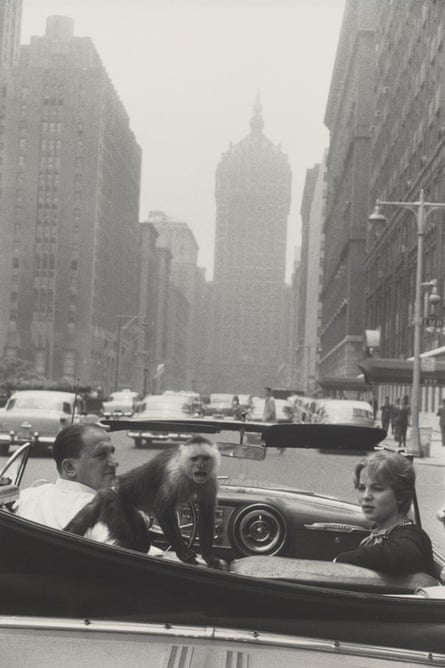
The second section of the show, named after Winogrand’s description of himself as A Student of America, ranges from California to Texas. If anything, his eye becomes more bemused by the America he encounters in all its contradictions. He photographed the Democratic National Convention in Los Angeles in 1960, lurking on the fringes of the main events to capture spectator reactions. In one mischievous image, the young John F Kennedy is just another face in a group of more animated faces gathered around him.
Four years later, Winogrand homes in on the hawkers peddling postcards of Kennedy’s assassination site on the streets of Dealey Plaza in Dallas. By then, his photographs had become (by his own restless standards) more reflective, even still. In another image taken in Dallas, a latter-day cowboy seems to float in the air above a pavement, sombre and out of time. On a New York street, a beautiful woman in a black coat and a white poloneck looks, at first glance, like a nun. Carrying a single white flower, she strides forward, looking either anguished or elated. The energy has shifted in these images and people seem more cut off from each other, more insular and self-absorbed.
The bleak tone continues into the final section, Boom and Bust, in which Winogrand photographed once more in Texas and Los Angeles where, as an unreconstructed son of the Bronx, he surely felt a stranger. It is harder to engage emotionally with these later pictures, but cumulatively, they denote a darker state of mind – Winogrand’s as well as America’s. Many were selected posthumously and they attest to his tangible sense of disenchantment with America and, perhaps, with photography. In one intriguing image, a woman lies prone outside a fast-food restaurant on an LA street as a Porsche rolls by and people dine inside, seemingly oblivious. It could be a still from a noir film or a real accident. There is an unsettling heartlessness here that is, in Winogrand’s eyes, profoundly American.
“I look at the pictures I have done up to now,” he once wrote, “and they make me feel that who we are and how we feel and what is to become of us just doesn’t matter. Our aspirations and successes have been cheap and petty. I can only conclude that we have lost ourselves ...” That aimlessness he sensed in America is all too palpable in Winogrand’s later work, and it seems to have infected him, too, profoundly altering his way of seeing even as he continued to photograph the world around him with a new urgency. He died in March 1984, one month after being diagnosed with cancer. This consistently illuminating retrospective makes beautiful sense of an unruly life and the torrent of images it produced.



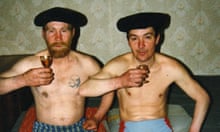
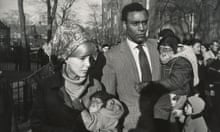
Comments (…)
Sign in or create your Guardian account to join the discussion